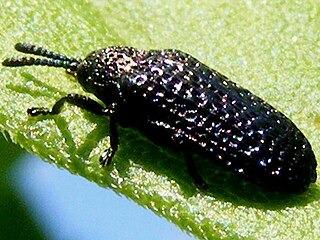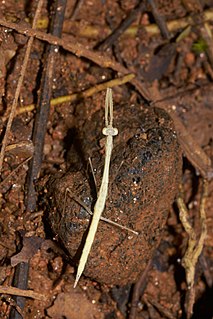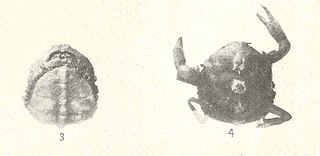
The Pinnotheridae are a family of tiny soft-bodied crabs that live commensally in the mantles of certain bivalve molluscs. Tunicotheres moseri is commensal with a tunicate. The earliest fossils attributable to the Pinnotheridae date from the Danian.

Peziza is a large genus of saprophytic cup fungi that grow on the ground, rotting wood, or dung. Most members of this genus are of unknown edibility and are difficult to identify as separate species without use of microscopy. The polyphyletic genus has been estimated to contain over 100 species.

Gephyromantis moseri, commonly known as Moser's Madagascar frog, is a species of frog in the family Mantellidae. It is endemic to Madagascar. Its natural habitats are subtropical or tropical moist lowland forests and rivers. It is threatened by habitat loss.
Thalassemys is genus of a Late Jurassic fossil sea turtle from Western and Central Europe, France, Switzerland, and Germany, close to the genus Plesiochelys, thus classified as an non-Testudines angolachelonian

Fenimorea moseri is a species of sea snail, a marine gastropod mollusk in the family Drilliidae.

Meinhard Michael Moser was an Austrian mycologist. His work principally concerned the taxonomy, chemistry, and toxicity of the gilled mushrooms (Agaricales), especially those of the genus Cortinarius, and the ecology of ectomycorrhiza. His contributions to the Kleine Kryptogamenflora Mitteleuropas series of mycological guidebooks were well-regarded and widely used. In particular, his 1953 Blätter- und Bauchpilze [The Gilled and Gasteroid Fungi ], which became known as simply "Moser", saw several editions in both the original German and in translation. Other important works included a 1960 monograph on the genus Phlegmacium and a 1975 study of members of Cortinarius, Dermocybe, and Stephanopus in South America, co-authored with Egon Horak.
Apterichtus moseri is a species of snake eel native to the northwestern Pacific Ocean where it is only known from Suruga Bay and the Kumano-nada Sea in Japan. It occurs at depths of from 111 to 114 metres. This species has been recorded as reaching 5 centimetres (2.0 in) TL for a female specimen.
Diamitosa moseri is a species of beetle in the family Cerambycidae, and the only species in the genus Diamitosa. It was described by Kriesche in 1927.
Phaeocollybia moseri is a species of fungus in the family Cortinariaceae. Found in Chiapas, Mexico, where it grows under pine, it was described as new to science in 1996 by Victor Bandala and Gastón Guzmán. It belongs to the section Versicolores of the genus Phaeocollybia. The specific epithet moseri honors Dutch mycologist Meinhard Moser, "on the occasion of his 70th anniversary and for his contribution to agaric systematics".
Gymnopus moseri is a European species of agaric fungus in the family Omphalotaceae. It was described as new to science in 1997 by mycologists Vladimír Antonín and Machiel Noordeloos from collections made in Sweden. Fruit bodies of the holotype collection were found growing among Polytrichum and in coarse humus and leaves under birch (Betula) and willow (Salix). Collybia moseri is a synonym proposed by Marcel Bon in 1998. The specific epithet moseri honours Austrian mycologist Meinhard Michael Moser.
Leucoagaricus moseri is a species of agaric fungus found in Europe. The species was originally described as Lepiota moseri by Solomon Wasser in 1975. The specific epithet honours Austrian mycologist Meinhard Moser. Wasser transferred the fungus to the genus Leucoagaricus in 1978.
Conocybe moseri is a mushroom species in the family Bolbitiaceae. It was described as new to science in 1980 by mycologist Roy Watling, from collections made in France. The specific epithet moseri honours Austrian mycologist Meinhard Moser. The fungus has been reported from the United Kingdom, growing in grassy areas, fields, and edges of woods. In 1995, it was recorded from Switzerland, from Ukraine in 2007, and from Russia in 2007. It was reported from India in 2015, where it was found growing on cattle dung.
Tubaria moseri is a species of agaric fungus in the family Tubariaceae. Found in Argentina, it was described as new to science in 1974 by Jörg H. Raithelhuber. The specific epithet moseri honours Austrian mycologist Meinhard Moser.
Hebeloma moseri is a species of agaric fungus in the family Hymenogastraceae. Found in Argentina, it was described as new to science by mycologist Rolf Singer in 1969. The specific epithet moseri honors Austrian mycologist Meinhard Moser.
Peziza moseri is a species of cup fungus belonging to the family Pezizaceae. It was officially described as new to science in 1974 from collections made in Israel. Fruit bodies are purple and cup-shaped, measuring 1–3 cm (0.4–1.2 in) in diameter. It fruits singly or in groups on burnt ground in coniferous forests.
Euparixia is a genus of aphodiine dung beetles in the family Scarabaeidae. There are about 12 described species in Euparixia.

Microrhopala is a genus of tortoise beetles and hispines in the family Chrysomelidae. There are about 18 described species in Microrhopala.

Deiphobe is an Asian genus of praying mantids: in the subfamily Miomantinae.
Afreumenes moseri is a species of potter wasp in the family Vespidae. It was described by Schulz and 1906.

Tunicotheres is a monotypic genus of crabs in the family Pinnotheridae, and Tunicotheres moseri is the only species in the genus. This crab lives commensally in the atrial chamber of a small ascidian. It is found in the tropical western Atlantic Ocean, the Caribbean Sea and the Gulf of Mexico.









